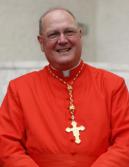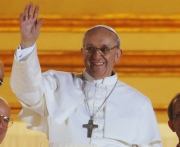 As the Easter Triduum approaches, we are propelled into the heart of the mystery of our Christian faith, the passion, death and resurrection of Jesus of Nazareth, Son of God. It is in his crucified and risen body that we are offered a return to God and in the same mystery of sacrificial love that we find a way home to our true selves and also to one another.
As the Easter Triduum approaches, we are propelled into the heart of the mystery of our Christian faith, the passion, death and resurrection of Jesus of Nazareth, Son of God. It is in his crucified and risen body that we are offered a return to God and in the same mystery of sacrificial love that we find a way home to our true selves and also to one another.
Like others, my wife and I began our journey toward Easter on Ash Wednesday but not with the imposition of ashes but at Westmead Children’s Hospital where our nine month old son underwent a morning ultrasound for a rare eye condition that had been discovered some weeks earlier. The sense of loss and shock we had felt those weeks ago, with the news that our first-born son was likely blind in one eye, was outstripped only by the dread of surgery and the small but real risk of infection and, at worst, complete blindness. With the passing of our friends’ child, born on the same day, and in light of our own son’s affliction, we no longer stored faith in statistical assurances.
It is difficult to express the heartbreak that accompanies the suffering of our loved ones and we can never prepare for the rawness of loss and vulnerability so close to home. In the long days and nights since that first diagnosis we looked upon our son with a mix of tenderness and helplessness, doing our best to carry on with the everyday practicalities of life, all the while handing the wellbeing of our son over to God day by day, with all the trust and all-too-human reluctance of those of whom more has been asked.
In the crucible of suffering and fear there is no room for second-hand anecdotes, about God giving only what one can bear or even for sentiments about the eventual meaning that suffering will bring, given only enough time. There is only the rawness of the experience, the silence of God in the focused ‘crying out’ of prayer, the inexpressible awareness of the wisdom of Hebrews, that it is, indeed, “a dreadful thing to fall into the arms of the living God” (Heb. 10:31).
 In the visits to the specialists that were to come, we were slowly initiated into a new world. We remember keenly the heartrending moment of pushing our young son through the hospital doors for the first time, now almost a ritual, and the distress of watching him squirm from afar under the careful handling of our doctors. Then, there were the other families and children we met along the way, many suffering to a far greater and incomprehensible degree, with cancer and profound disability. We shared space with these families each week with sympathy and deference. The quiet sadness of a hospital waiting room can bring life to its essence without a hint of sentimentality.
In the visits to the specialists that were to come, we were slowly initiated into a new world. We remember keenly the heartrending moment of pushing our young son through the hospital doors for the first time, now almost a ritual, and the distress of watching him squirm from afar under the careful handling of our doctors. Then, there were the other families and children we met along the way, many suffering to a far greater and incomprehensible degree, with cancer and profound disability. We shared space with these families each week with sympathy and deference. The quiet sadness of a hospital waiting room can bring life to its essence without a hint of sentimentality.
In the midst of our own uncertainty it was those furthest from our day-to-day life, but closest to our experience, who offered us hope and succour. A couple interstate who have suffered deep loss in their own life reminded us of the way in which our reality had changed over the years, incomprehensibly even, from praying and giving thanks for our vocations, our marriages and pregnancies, to now begging for the lives and wellbeing of our children. As these companions on the way reminded us, so is the advocacy required of us as parents.
Then there were two Cistercian monks, friends of ours through an internet connection and a shared love of the monastic tradition who, though so different in vocation, united with us in prayer and petition. There is great solace in communion. With them, we pelted the heavens with psalms.
Over the coming weeks and as surgery loomed, we had our home written prayers, relished every moment of play we could find, and in John’s Gospel heard Christ speak at the waters of Siloam,
His disciples asked him, ‘Rabbi, who sinned, this man or his parents, that he was born blind?’ Jesus answered, ‘Neither this man nor his parents sinned; he was born blind so that God’s works might be revealed in him.’ (Jn 9:2-3)
We waited in faith.
It was a Monday morning when my wife received the call that there had been a cancellation in theatre and our son’s surgery had been brought forward by weeks, to the following day. On the morning of his admission, our friend, a priest, blessed the three of us before we took leave for the hospital.
The day seemed an eternity. After admission and a lengthy wait, we watched our son slip under general anaesthetic and walked away from the theatre in one another’s arms and in tears. It would be the longest time our son had been away from his mother since birth.
 We almost ran to the recovery room to greet him as he emerged from surgery, heavily bandaged and weary but with all having gone to plan. While his sight in one eye was likely to remain poor throughout his life, the offending obstruction had been removed without complication. After observation for a further few hours, we could take our son home.
We almost ran to the recovery room to greet him as he emerged from surgery, heavily bandaged and weary but with all having gone to plan. While his sight in one eye was likely to remain poor throughout his life, the offending obstruction had been removed without complication. After observation for a further few hours, we could take our son home.
This Easter we have been drawn into the paschal mystery without our asking. Indeed, no one runs toward the Cross for it promises to cost us much more than we are willing to give. Still, over the years we learn to entrust ourselves a little more to the ‘logic’ of this way. Sometimes we are carried by others and other times sustained by faith alone.
This Triduum we give thanks for all that we have, for out of the depths of limitation and fear has emerged a stronger faith, a greater hope and a deeper love.




















